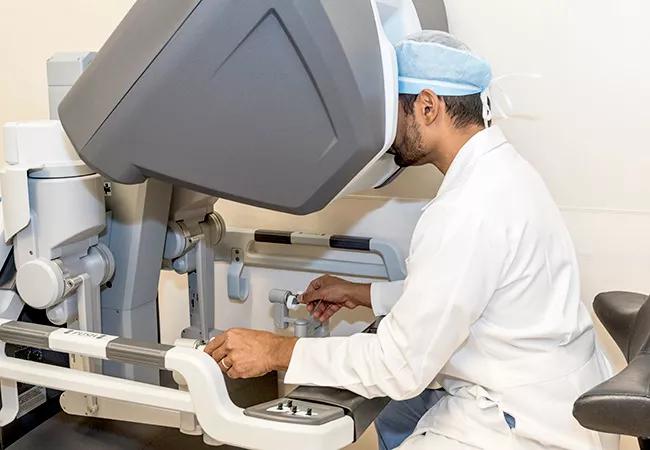Technological advances make complex surgeries possible

Robotics have been used to perform endoscopic radical prostatectomies since the turn of this century. Also known as telemanipulation devices, the robotic systems allow delicate and precise movement in spaces too tight to accommodate hands. Advances in technology now enable surgeons to use a minimally invasive approach for a multitude of more complex surgeries that previously required a large incision.
Advertisement
Cleveland Clinic is a non-profit academic medical center. Advertising on our site helps support our mission. We do not endorse non-Cleveland Clinic products or services. Policy
“Thanks to recent improvements in robotics technology, even advanced surgeries, including those involving the removal of multiple organs, can now safely be performed with a minimally invasive approach,” says Jayram Krishnan, DO, MBA, a urologist with Cleveland Clinic’s Glickman Urological & Kidney Institute, and a proponent of advancing the use of robotics for minimally invasive urologic surgery.
Because of the expense of the system and the specialized training needed to operate it, robotic-assisted surgery is generally available only in major medical centers and large hospitals. The system consists of four jointed (“wristed”) arms with 7 degrees of freedom. The surgeon manipulates the controls using a processor that filters, scales and relays his or her exact actions, correcting for tremors, and allowing for more precise movement and better range of motion than the human hand.
The arms are controlled from a console, typically in the same room as the patient, although they can be operated remotely. The console allows procedures conducted from a seated position while viewing the target area magnified in 3-D in a single line of sight, unlike in conventional procedures in which the surgeon must stand and continually look away from the surgical area to view a video monitor. A recent development is that all four quadrants can now be operated on without repositioning either the patient or the robot.
Two of Dr. Krishnan’s recent cases are described below.
A 62-year-old man presented with high-grade transitional cell carcinoma of the bladder. A year before, he had a left nephrectomy for renal carcinoma, performed with traditional open surgery. His remaining kidney functions poorly, making him dependent on dialysis.
Advertisement
At this time, the patient required resection of the bladder, and because of the risk of future cancer to the prostate and the malfunctioning kidney, he was advised to have them removed at the same time.
The entire procedure was done with a minimally invasive, robotic-assisted procedure through five 1-cm incisions and one larger incision to remove the organs. All three organs could be removed in one piece along with the ureter.
The minimally invasive approach offers major advantages over a traditional open approach. Since there is no need to cut through muscle, recovery time is faster. The patient returned home in two days (compared with one and a half weeks required for open surgery), and he experienced less pain and a faster return to normal activity. Other advantages include less blood loss, risk of infection and scarring.
More than a year later, the patient is doing well and remains cancer-free.
A 67-year-old man presented with transitional cell carcinoma of the bladder and ureter in addition to adenocarcinoma of the prostate.
He required removal of the prostate, one-third of the bladder, the distal one-third of the ureter, and the right kidney. Reconstruction was required with ureteral reimplantation on the right side. The entire surgery was performed in a single robotics-assisted, minimally invasive procedure in six hours, about the same time one would expect for a traditional open approach.
Nine months later, the patient is doing well. Follow-up every three months postoperatively with CT and cystoscopy has revealed no evidence of cancer recurrence.
Advertisement
Before incorporating the new technology into a surgical practice, Dr. Krishnan emphasizes the need for specialized training in robotic techniques, which he acquired through a fellowship with Cleveland Clinic. He estimates that he has used robotics in about 400 cases over the past three years.
“New advances allow us to constantly push the limits of robotic surgery,” said Dr. Krishnan, who uses a minimally invasive approach for all bladder, prostate, and kidney surgeries whenever feasible and warranted. “It is important for the medical community to be aware of the possibilities of this technology.”
Advertisement
Advertisement

First-of-its-kind research investigates the viability of standard screening to reduce the burden of late-stage cancer diagnoses

Global R&D efforts expanding first-line and relapse therapy options for patients

Study demonstrates ability to reduce patients’ reliance on phlebotomies to stabilize hematocrit levels

A case study on the value of access to novel therapies through clinical trials

Findings highlight an association between obesity and an increased incidence of moderate-severe disease

Cleveland Clinic Cancer Institute takes multi-faceted approach to increasing clinical trial access 23456

Key learnings from DESTINY trials

Overall survival in patients treated since 2008 is nearly 20% higher than in earlier patients